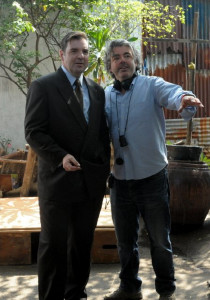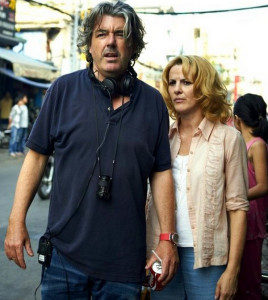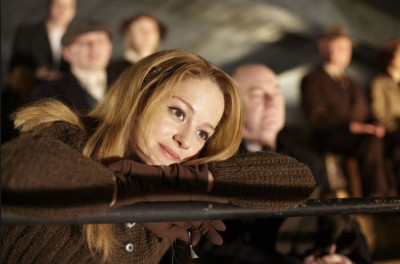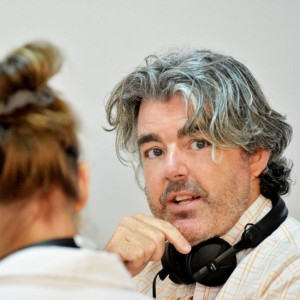Embarking on his own five year journey, writer/director Stephen Bradley brings Christina Noble’s story to the silver screen with the film NOBLE. As I quickly learned during our recent exclusive one-on-one interview, with unending engaging enthusiasm, Stephen Bradley is as indefatigable as Christina Noble herself.

Christina Noble is relatively unknown outside of Ireland and the United Kingdom. An inspiring woman, Noble faced loss, hardship and poverty as a child growing up in the slums of post WWII Dublin. But Noble’s faith and positivity not only kept her alive, but helped her thrive and overcome every challenge and bit of adversity the world threw at her. That strength eventually led her to Vietnam in 1989 where she began helping the children of Saigon; children who, like herself as a child, were homeless, hungry, alone and in need of love. And through her perseverance and determination, the Christina Noble Foundation became a reality, eventually expanding with programs across Vietnam and into Mongolia, while earning Christina Noble the honor of Officer of the Most Excellent Order of the British Empire in 1997 for her work as a children’s rights activist and charity worker.
Initially unaware of who Christina Noble was, Bradley credits his wife, actress and comedienne Dierdre O’Kane, for opening his eyes. “She read Christina’s books in the 1990’s and has always been a little bit obsessed by Christina as a person and her work. When Dierdre was at the height of her powers as a stand-up comedienne, she did several annual events of fundraising for the Christina Noble Foundation. Then Dierdre and I moved to London and in 2008 we sat down to talk about something we might collaborate on. She said, ‘Listen, there’s only one thing I want to do and that’s the story of Christina Noble.’” With those words, and O’Kane at the ready, Bradley embarked on what would become a five-year journey.

“The first two years were really me traveling back and forth to see Christina in Dublin, to get to know her and hear her story; and I mean “really” get to know her so I could write the screenplay. And also for Christina to trust us enough to give us the rights to make the film.” Ultimately, in 2011, Bradley’s efforts were rewarded when Noble “made the decision that she did trust us enough, that we got to know each other enough, and I’d spent enough time talking to her about all the stories that aren’t necessarily in the books or in the public domain. At that point she said, ‘Listen, it’s your film now. Off you go. You don’t need to consult me or anything.’ . . . I suppose in the sense I felt those two years of ground work just gave her that confidence, but it was an amazingly generous and necessary gesture in the sense that I obviously couldn’t have had looking over my shoulder as I made the film. . . And she didn’t see the film until it was completely finished!”
What struck Bradley most about Noble over the two years of meetings was that, “She’s a larger than life character. I came at it at a different way than Dierdre did. . . I had to come at it from a completely different angle in the sense that, first and foremost, having to write the screenplay and treat it as a dramatist. In that sense, Christina is a very complicated character. She’s got a lot of conflicting facets to her character and she’s a larger than life character. . . [S]he’s got that classic kind of hero’s journey to her as well. All of those obstacles she’s overcome to break out in the end and into the blue sky of what she has done. I was thinking first and foremost as a dramatist and from that point of view she’s just a fascinating character to make a film about.”
But that larger than life persona, with a lifetime of experiences, provided another challenge for Bradley – which chapters and stories of Noble’s life to incorporate into the script. “In a way, that was one of the hardest things. I did write some other storylines and some other subplots and some of the even harder events that happened to her, and it was a question of honing that down and trying to get to the essence of Christina’s character, and therefore, jettisoning – not wanting it to be too much story for an audience.”

Because of the 40 year expanse of time to cover, Bradley needed to construct a script that’s not only engaging for an audience, but true to Noble and life’s events. Approaching the story with a non-linear format proved to be the way to go. With NOBLE, he found that sweet spot as he takes the audience back and forth in time but in looks into the 1950’s and 70’s, gives little breadcrumbs of information with each visit, just enough to give the audience a sense of what happened and how that shaped Noble’s life in the 1989 “present day”, while deepening interest and creating a desire for “more”, all of which would slowly be dispensed as the film progressed. Looking at it from the audience’s point of view, Bradley believes “There’s two things about audiences. One, they are really savvy. People know how to watch films now. They’ve watched a lot of films, they know the language of cinema and television, and they join the dots really fast. But they also like to be given little puzzles, I think, to work the brain, the storytelling brain, and to engage with the film. That’s what I was trying to do there.”
Key to making the non-linear format of the film work was the casting and “getting the cast of the three Christinas (representing ages 10-years, teenaged and adult) to completely match in the way that they do. Also, that the audience loves each one of them so that you’re not in danger of spending some time with one of them and cutting away to another and the audience is gonna go, ‘No, I don’t like this one so much. Why couldn’t we stay with the other one.’ I think that’s a really important part of the casting end of those three amazing performances by those three actresses. That really helped me. That gave me the confidence in the edit to go through with what I had written in the screenplay, which was that structure.

And what about the three actresses who play Christina Noble? Gloria Curtis, Sarah Greene and Dierdre O’Kane. “As I said, that is probably the single most important thing with the film because as you said, if there was a flaw, then you lose the audience. And as an audience you then get frustrated and annoyed with it. I always referenced the film ‘Shine.’ That had the same age groups. It had David Helfgott as a 10-year old, a late teenager and then the Geoffrey Rush age. That was a great guide for me in showing me how important that was to get right. In a way, I often say to actors that part of the breaks in this business is there’s either a script coming down the tracks for you or there isn’t.”
While Dierdre O’Kane as the adult Christina Noble was a given, finding the teenaged and 10-year old Christinas are stories unto themselves. “In Sarah Greene’s case, she had been working away in Ireland, hadn’t really broken through despite the fact she’s an incredible actress and incredibly beautiful. I saw her in the National Theatre in Ireland. I saw her do a play. I got a ticket for the last night of the play and she just dominated the stage and seduced the audience. The whole audience fell in love with her. She was magnetic. I knew she had a very similar energy to Dierdre. I intended to be very professional and audition loads of actresses for that role but Sarah Greene came in on the first day and as soon as I saw her in this role, I knew that I had to offer it to her. So that was a great break for me as well. And she and Dierdre are just a fantastic match.” Once cast and shooting was underway, “[E]ven though she didn’t shoot in Vietnam, I brought [Sarah] to Vietnam to watch Dierdre in action so she could feed off Dierdre.”

For O’Kane, going beyond her decades long knowledge and “bit of obsession” with Christina Noble and her life’s work, in addition to reading each and every draft of the script along the way, together with husband Bradley, the couple “lived and breathed the film solidly for a year before we started shooting.” Bradley describes O’Kane as being “incredibly focused. She went to Vietnam with Christina for ten days before we started shooting and shadowed her 24 hours a day to get under her skin. . .We had talked about the film and the script so much that by the time we came to shoot, we were both completely on the same page. We were both in the zone.”
On seeing NOBLE, what proves amazing is the performance of Gloria Cramer Curtis as 10-year old Christina. The persona and essence Curtis gives to Christina is carried through by Greene and O’Kane, but the film was actually shot in reverse. “We shot all of Dierdre’s stuff first and then I let Sarah and Gloria feed off of what Dierdre had done.” As Bradley notes, “It’s hard to find great child actors. It’s a question of seeing a lot of them and finding the ‘Gloria’ that’s there amongst all of them.” When it came to casting the young Christina, Bradley had only seen Curtis on a tape but his enthusiasm in describing his finding her is infectious. “She hadn’t actually learned the lines so she probably wasn’t as good as some of the others at that point, but I just saw something in her. Then I did about four auditions with her to make sure that she was as good as I thought she was and that she could take direction. She was just amazing.” One of the endearing touchstones of the film which is carried throughout by each of the actresses are little moments of lightness with Christina talking to God in a very childlike manner of bartering and bargaining with him. Although one might think this is a cinematic move, Bradley assures us that’s not the case. “That kind of childlike way of talking to God is something that Christina has carried right through her life.”

Equally strong to Bradley’s story structure and casting is the film’s cinematography and for that job, Bradley called upon Trevor Forrest. Describing him as “a young guy” and “a great cinematographer”, Bradley discovered him through another film. “I had seen him shoot a film called ‘Una Noche’ that won a prize at Tribeca and was shot in Cuba. That had that similar vitality to it that I needed for Christina’s story.” Also essential for Bradley was the film be a “roller coaster of emotional entertainment rather than a dreary ordeal. . . It was all about finding the essence of Christina’s character which, in all aspects of the film, including the cinematography, is what kind of drove me on. One of the things with Christina is she doesn’t have any gray or black or darkness in her life in terms of the colors that she brings to all of her surroundings. I wanted to use that in the cinematography. We shot the film on widescreen and we shot it on 35mm. We shot it on film, probably the last time I’ll ever get to shoot on film in my life. Actually, it was the last film that was processed at the Technicolor lab in London. . . But I wanted to shoot on film because I was in the 1950’s, I was in the 1960’s and I was in 1989 which was all pre-digital. It also gave me other tools to play with. Like we used three different stop-types for each different period, and a different grading method; all of which film gave us more latitude with.”
Also important to Bradley and in choosing Forrest very essence and vibrancy of Vietnam. “When you are in Vietnam, the light and the color and the life of the street, you just suddenly realize that you’re going to be able to capture a sort of epic scale to this film on a relatively modest budget just by being in Vietnam. Again, that was part of my thing with Christina’s story. It’s an epic story, it’s a classic modern day hero’s journey with real scale to it. What the streets of Saigon let me do, along with Trevor’s cinematography, was included in that scale in the film.”

Color and production design is an important storytelling tool for Bradley and particularly with NOBLE. Color in the daylight scenes in Vietnam have vibrant pops of turquoise, slips of reds and pinks while nighttime is filled with darker, richer saturations dotted with neon. Bradley gives much credit to his production designer Cristina Casali. “We had to bring Ho Chi Minh City back to the Saigon of 1989. We allowed ourselves a couple of licenses, like, there wouldn’t have been that many motorbikes in those days like there are in some of the wider street scenes. Cristina is very clever. She had a whole bag of tricks of ways of covering up anachronisms, and ways of bringing color to sharp moments in the frame. Also, sometimes we closed down the streets and we introduced traffic which was pure 1989 cars and bikes and bicycles and people. That was full on set dressing. So there were a few times we had full on set dressing and there were other times that we were sort of massaging what was there and framing to suit our period.”
As comes as no surprise, shooting in Vietnam presented many logistical challenges for Bradley and his team. “From the start you’re working in 30-35 degrees Centigrade [90-95 degrees Fahrenheit] and it’s hot! It’s hot! Then it’s a bustling, very vibrant, very busy city. So it was difficult shooting there. We had an amazing producing partner, Melanie Gore-Grimes, and a lot of her experience was in shooting large scale commercials for Ridley Scott’s company in far off locations. She was able to go into Vietnam and really get organized. It took us about eight months to get all the permissions that we needed and to really get our act together in terms of the different way of shooting in Vietnam.” Interesting is that despite the growth and revitalization in Vietnam since the war very few films have shot in Vietnam so Bradley “actually ended up bringing 35 crew from the UK with me, as well as probably 100 Vietnamese people in Saigon who worked on the film. It was a new way of working.” During pre-production, Bradley was also “shuttling between Vietnam and Liverpool which is where I shot all the Irish and English material. So I was running two art departments and shuttling between the two. It was challenging, particularly on the budget level, but I knew that Saigon was gonna offer up all the things you’ve described that are there, so it was really worth putting in that work.”

While Stephen Bradley and his audience have learned about Christina Noble through the journey of NOBLE, one has to ask what Bradley has learned about himself on his journey in bringing this story to life. “Wow. That’s an amazing question. . .I’ve been writing and directing for 20 years now and I suppose the most exciting thing and the thing that’s most satisfying and that I’ve learned a little bit about myself doing it, is just having the confidence to do all of those roles. There have been ups and downs. We’ve got to this stage but one of the greatest battles has been pushing the film up the hill so it can reach its audience. I hope that we’ve all shown a bit of tenacity. At times it looked like we wouldn’t get to where we are now, even though we knew we had the film that we had. I think I’ve learned a lot about the film business and I suppose about myself in relation to the film business and how, if you do keep going and you’re confident in the material and the material has turned out well, then you’ve really just got to keep pushing.”
This journey has also given Bradley food for thought on the film industry as a whole, finding that “the film industry is totally in flux and I think there are new ways of finding audiences. That’s not just to do with digital technology because obviously I’m a big fan of the theatrical experience and I want this film, which has been shot as a widescreen experience taking an audience to Vietnam and into the 1950’s, to be seen on the big screen, but I hope that people are going to still have that desire to have the theatrical experience very much as I would like to keep making films for theatres.”

As NOBLE hits those theatres across the US, not one to rest on his laurels, Bradley is back at work. While admittedly difficult to get back to the writing after the years spent on NOBLE, “I have finished a script that’s ready to go into production . A psychological thriller set in the Second World War in France that I’m hoping to do with Cillian Murphy. . .Then I’m developing a comedy with five actors who became best friends on another film that I made, one of whom is Domnhall Gleeson who’s in ‘Ex Machina’ at the moment and is in the new ‘Star Wars’ and all of that. We’re developing a film together with four of his best friends who are all very fine actors and doing very well in Ireland and the UK. That’s a fun project. And I’m writing a storyline for a big family crime saga set in the 1930’s in New York.”
As a final postscript to our interview, Stephen Bradley left me with these words which apply not only to the making of a film, but of life. “Whenever we have problems, all we have to do is look at the story of what Christina did and our problems pale into insignificance in terms of all the things she overcame. That was always a great boost. We could always feel fortunate where we were.”












